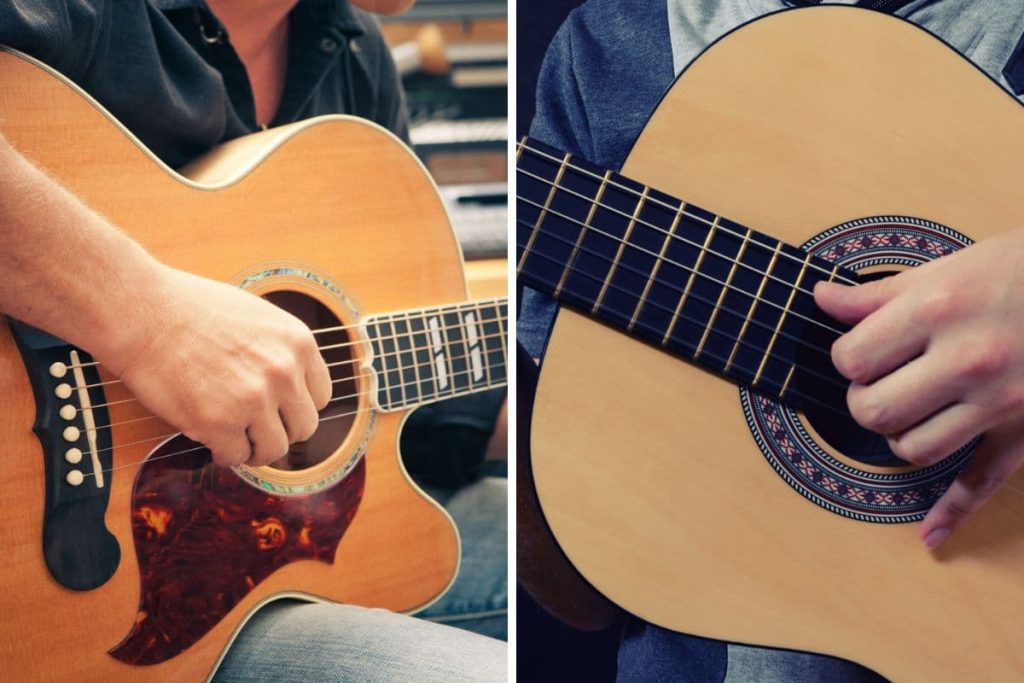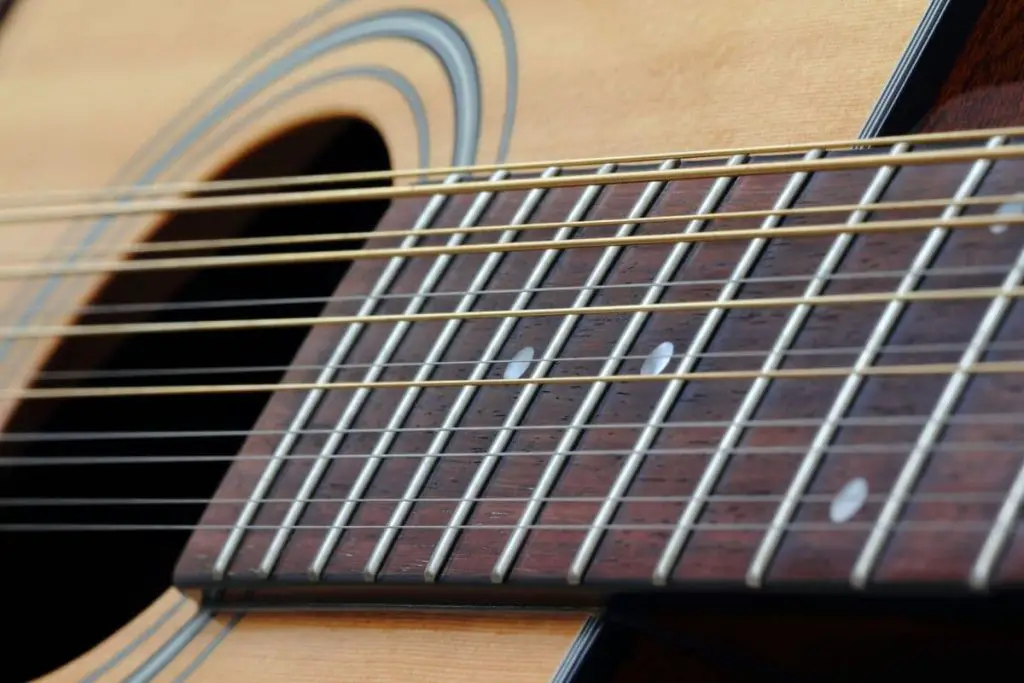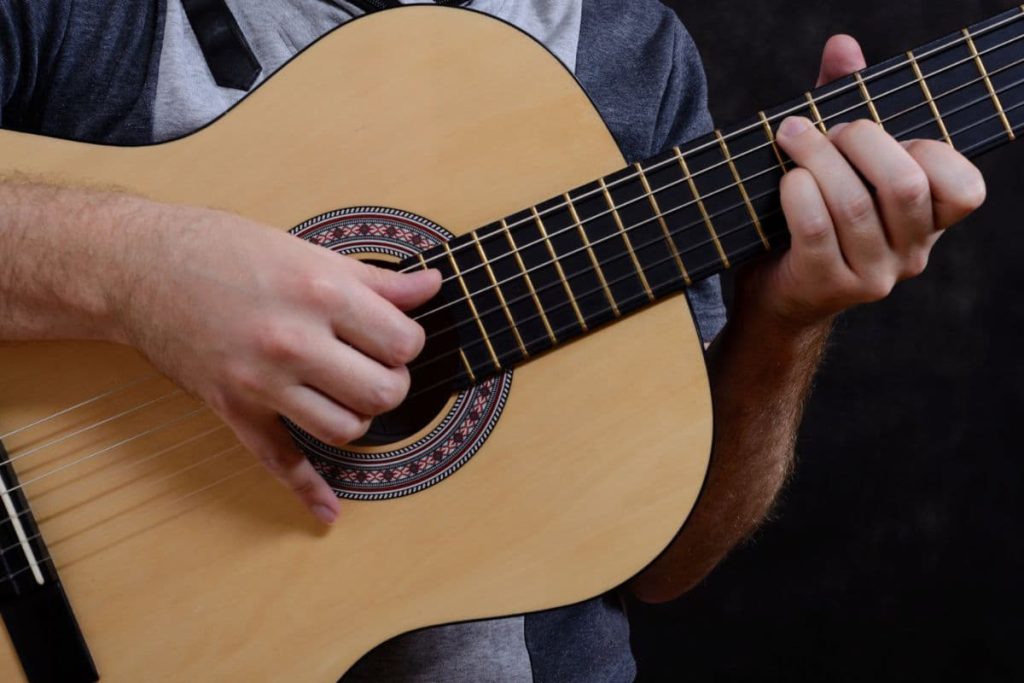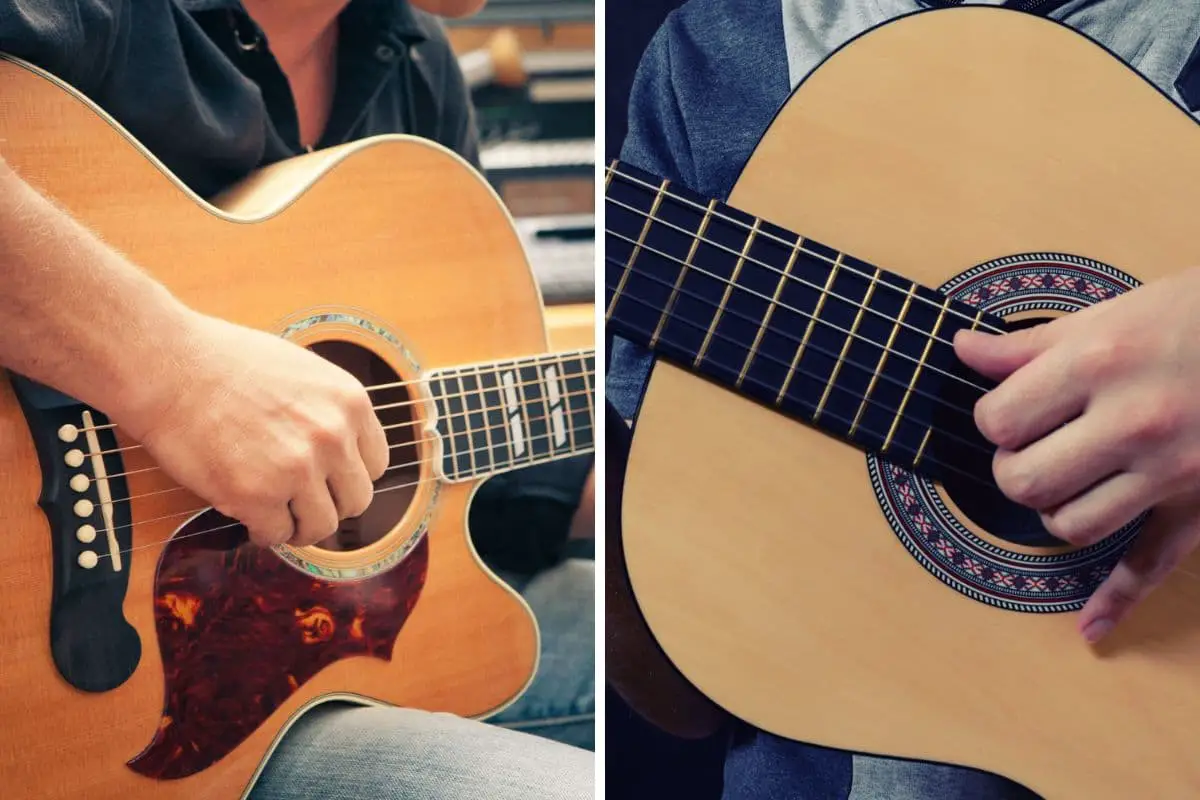Playing the guitar is one of the most common hobbies people engage in globally. It is an engaging activity that has the potential to create lasting memories, hence the reason why more people want to learn. However, before beginning your classes, it is vital to understand the similarities and differences between the different types of guitars.
To know whether your guitar is classical or acoustic, look for differences in design, playing styles, construction materials, and instrumentality. Classical and acoustic guitars have varying shapes and sizes, are made of different materials, and have different ranges of tones.
Acoustic and classical guitars do have many similarities as they share many of the same components, for example, the bridge, fretboard, neck, body, soundhole, headstock, and strings. These similarities can make it tricky to differentiate between the two. Keep reading for an in-depth look into the difference between classical and acoustic guitars.
👇😀👇NOTE👇😀👇
If you want to find out what my recommended guitar gear is, then here is what I recommend on Amazon:
- Fender Cutaway Acoustic-Electric Guitar Bundle (MY FAVORITE GUITAR)
- Snark SN-8 Super Tight All Instrument Tuner (Easiest Tuner I’ve Used😏)
- 6 String Acoustic Guitar Capo (Best CAPO for quick changes)
- Dunlop Max Grip 1.0mm Nylon Picks (Thick Guitar Pick So You Don’t Lose Grip!)
- Universal Guitar Stand (Cheap & Minimalist Guitar Stand I Recommend)
- Levy’s 2″ Wide Quick Adjust Guitar Strap (Best Guitar Strap For Any Level)

1. Compare Their Body Shapes and Sizes
Guitar manufacturers produce them in varying shapes and sizes. However, it is the norm for acoustic guitars to be larger compared to classical guitars. However, parlor acoustic guitars are smaller than classical guitars.
The smallest classical guitar has a Piccolo-like body, while the largest has a Contra bass style, with the most popular type of classical guitar having a Concert-style body. On the other hand, acoustic guitars come in wider-ranging sizes compared to classical guitars. Some common acoustic guitar shapes include an auditorium, jumbo, concert, grand concert, orchestra, travel, and dreadnought.
The dreadnought-style acoustic guitar is the most common among performers. Classical guitars have slimmer waists than acoustic guitars, while acoustic guitars have rounded backs.
2. Compare Their Body Weight
A guitar’s size considerably influences its weight. Most acoustic guitars are heavier than classical guitars as they are generally larger. The shape of an acoustic guitar also contributes to its weight, which often makes acoustic guitars heavier than classical guitars.
Acoustic guitars require more construction material than classical guitars since they have wider waists and rounder backs, meaning manufacturers chip away less wood in their construction. In addition, acoustic guitars have steel strings which add to their weight compared to classical guitars with lighter nylon strings.
3. Check the Strings
As noted, classical and acoustic guitars use different types of strings, which is one of the most significant differences between them. Classical guitars use nylon strings which are usually thicker than the steel strings used in acoustic guitars.
The classical guitar strings are thicker since the treble strings (G, B, and high E) consist of nylon, while the bass strings (E, A, and D) consist of a nylon core with a metal exterior, like copper.
The strings on a classical guitar are also more transparent due to the nylon material, while an acoustic guitar’s steel strings are usually gold or silver-plated.
Note that the steel strings on acoustic guitars do not have to be steel; they could also be made of nickel or bronze.
4. Test the Guitar’s String Tension
The string tension in acoustic guitars is usually stronger than the tension in classical guitars. That is because steel strings consist of harder material compared to nylon strings, meaning they need to have greater tension to produce the desired sound. Some people attempt placing nylon strings on acoustic guitars, but that only results in a guitar that produces very faint sounds.
On the other hand, trying to put steel strings on a classical guitar can damage it. A classical guitar’s design does not allow it to handle the amount of tension required by steel strings. Therefore, prolonged use of high tension strings on classical guitars will pull the bridge and bow the neck resulting in irreparable damage.

5. How the Guitar Feels
Due to the differences in body shape, size, and weight, holding and playing a classical guitar feels different from playing an acoustic guitar, especially if a player predominantly plays one type over the other.
For those accustomed to the classical guitar, the larger size of the acoustic guitar can initially make you feel uncomfortable because you have to reach over more than usual to reach the chords. The strings of the two guitars also feel different, with the nylon strings on the classical guitar being softer while the steel strings feel metallic and stiffer.
Overall, the differences in feel make a classical guitar ideal for beginners since it is easier on the fingers and requires less strain.
6. Confirm Whether It Has a Truss Rod
Primarily, a truss rod is a feature found in acoustic guitars but not in classical guitars that runs along the length of the instrument’s neck. A truss rod’s main purpose is to counter the pressure steel strings exert on an acoustic guitar neck.
This is an adjustable feature, so you can determine how much pressure you want to apply to the guitar’s neck. Classical guitars do not need a truss rod since the nylon strings do not exert excess pressure on the guitar neck to risk its structure.
You can see the truss rod by holding the guitar with the neck facing you, and you will notice a rod or hole beneath the plastic plate beside the headstock’s top nut.
7. Compare the Fretboards’ Widths
The fretboard or fingerboard on an acoustic guitar is usually narrower than the fretboard on a classical guitar. Additionally, a classical guitar’s fretboard is usually flat, while an acoustic guitar has a curve or angle.
Moreover, acoustic guitar fretboards have fretboard markers which are dots along the length of the fretboard. The markers help players recall the chords, minimizing the risk of making mistakes. The markers are usually on the third, fifth, seventh, ninth, twelfth, and fifteenth fret.
However, if you have a classical guitar that lacks markers, you can apply the markers using paint, especially if you are in the early stages of learning to play.
8. Check the Chords
The classical guitar’s wide neck creates more space for a player’s fingers, making playing convenient for persons with larger-than-average hands. Moreover, the spacing helps people avoid making mistakes while playing.
However, people with smaller hands might find it inconvenient because it would require stretching to reach all the chords. In addition, the back of an acoustic guitar’s neck is usually more rounded than a classical guitar’s, which is often flat.

9. Check for Sound
Sound is a critical factor in determining which instrument you will purchase. The most significant contributors to the differences in sound between acoustic and classical guitars are their strings, shape, and construction material.
Classical guitars produce a soft, relaxed, and harmonious sound, while an acoustic guitar’s sound is metallic, loud, and resonates longer. The nylon strings of a classical guitar make it possible to produce subdued sounds, while the large size of the acoustic guitar allows it to produce louder sounds.
The wood used to make a guitar also influences sound generation. The woods used to manufacture guitars are called tone woods because they can produce sound when hit. The type of wood used at the top, sides, and back do not have to be the same. The manufacturer can mix the types of wood to modify or manipulate the sound produced.
Top woods have the most influence on the sound, and some examples include spruce, mahogany, maple, and cedar. The back and sides can consist of the type of wood. The wood chosen must amplify or muzzle the sound produced. Some examples include rosewood, sapele, mahogany, and maple.
10. Compare the Genres They Play
The sound a guitar generates also influences its application in different genres of music. Ideally, you can play any genre of music using either the classical or acoustic guitar; however, some genres blend well with their unique natures.
For instance, as the name suggests, classical guitars are perfect for playing classical music in addition to flamenco, a genre native to Spain. On the other hand, an acoustic guitar has greater applications compared to a classical guitar. It is popular among artists who perform folk, country, and pop music like Bob Dylan and Ed Sheeran.
11. Size of the Neck
The neck of a classical guitar is wider than that of an acoustic guitar. The neck’s width is measured at the guitar nut, a piece of plastic or ivory near the headstock. Measuring from the nut is preferred since the width of the neck expands as it moves towards the guitar’s body.
The increased width of a classical guitar’s neck helps accommodate its thick nylon strings. Conversely, the steel strings used in acoustic guitars are slimmer, requiring less space along the neck.
12. Neck-to-Body Joint
Given that the body of a classical guitar is smaller than that of an acoustic guitar, it also means the neck of the classical guitar is shorter than the neck of an acoustic guitar. That is because the neck of a classical guitar joins the body at the twelfth fret.
On the other hand, the neck of an acoustic guitar joins the body at the fourteenth fret. However, traditional acoustic guitar necks did join the body at the twelfth fret, similar to classical guitars. The same still applies to specific types of acoustic guitars like parlor guitars.
Checking where the neck of a guitar joins the body can be one of the easiest ways to spot whether you’re dealing with a classical or an acoustic guitar.

13. Appearance of the Bridge
The bridge is the part of the guitar that holds the strings on the guitar’s body. You fasten the nylon strings around the bridge in classical guitars to secure them. In acoustic guitars, the steel strings have balls held in place by bridge pins at their ends.
The knotting system in classical guitars makes for a more complicated system of changing and fastening strings than an acoustic guitar’s system. Moreover, the bridge in classical guitars is located further away from the soundhole compared to the distance between the soundhole and bridge in acoustic guitars.
14. A Headstock or Tuning Peg
The headstock is the guitar’s top part that contains the tuning pegs. The main difference in the headstock is that the classical guitar contains a slotted headstock while the acoustic guitars contain tuning pegs.
The tuning pegs are a recent invention only seen in modern guitars, making tuning an acoustic guitar very convenient and easy.
On the other hand, a classical guitar’s slotted headstock makes tuning the guitar complex. However, it offers other benefits like applying downward pressure to the nylon strings, thus improving the instrument’s sound output. Moreover, the pegs in classical guitars are either plastic or metallic, compared to acoustic guitar tuning pegs that are exclusively metallic.
15. Compare the Required Strumming Technique
You can strum the chords using your hands or a plastic pick when playing the guitar. Using your hands is favorable when playing a classical guitar since its nylon strings are soft and less likely to cause discomfort. However, you should avoid using plastic picks on a classical guitar since it might cause damage to the strings.
Moreover, classical guitars strummed using plastic picks do not generate the desired sound. On the other hand, using plastic picks is the best option when dealing with an acoustic guitar because the steel strings can handle the force applied by plastic picks;. Thus, using your fingers can be painful.
16. Check if It Has a Pickguard or a Golpeador
Some classical guitars, like the flamenco guitar, have a golpeador, while acoustic guitars have a pickguard. A pickguard or scratchplate is an object made of plastic or any other material found under an acoustic guitar’s sound hole. Its main purpose is to protect the guitar’s finishing from scratches or dents caused by picks.
Conversely, a golpeador is a type of pickguard found on classical guitars that serves the same purpose as the pickguard. People who play flamenco guitars also use the golpeador to add flare to their compositions because it is a striking form of playing. Acoustic guitars lack a golpeador; thus, it is crucial to avoid constantly tapping the wooden finishing, avoiding wearing it out.
If your guitar has a golpeador, then you know you are dealing with a classical guitar.
17. Left Thumb Use When Playing the Guitar
If you’re watching someone play a guitar and are wondering whether it’s acoustic or classical, you might be able to tell from the placement of their thumb. Placement of the left thumb is the main difference when comparing playing classical and acoustic guitars. Classical guitar players prefer placing the thumb at the back of the neck since it aligns with the posture required to play the instrument.
On the other hand, acoustic guitar players like having the left thumb hanging on top of the neck. It allows them to use it whenever they need to reach a chord. However, the final decision is a matter of preference because not every guitarist can shift between the two styles.
18. Right Hand Use When Playing the Guitar
The differences in right-hand use relate to the number of fingers or tools used while playing. Classical guitar players prefer using their fingers to play instead of picks. They rely on the right thumb, index, middle, and ring fingers.
On the other hand, acoustic guitar players prefer to use plastic picks. Therefore, determining right-hand use also requires considering other factors like how to care for nails, the kind of picks to use, and the intensity of strumming.
19. The Required Posture When Playing
Your posture is vital when playing the guitar because it helps you manage the guitar’s weight. Since acoustic guitars are heavier than classical guitars, the posture adopted by guitarists depends on whether they are playing the classical or acoustic guitar.
With an acoustic guitar, players mostly place the guitar on their right leg with the guitar’s neck resting on their lap. Conversely, players let the guitar’s neck rest on their left leg’s lap when playing a classical guitar. In addition, they use a footstool to raise the guitar to a specific angle.
Lastly, it is possible to play an acoustic guitar while standing with the help of a strap to keep it balanced, while most classical guitar players avoid playing while standing.

20. Average Price
Contrary to what you may have imagined, classical guitars are cheaper than acoustic guitars since they are smaller, require fewer construction materials, and use relatively affordable nylon strings compared to the steel strings on acoustic guitars. However, the price also varies based on the quality of the materials used to manufacture the guitar.
It is advisable for a beginner to buy a relatively cheap guitar while you learn how to play, but do not buy the cheapest one available since you risk buying something that will not last and interfere with your learning process.
You can upgrade to a more expensive guitar once you establish it is an activity you intend to indulge in for the foreseeable future. The most important thing is to keep practicing, whether you’re dealing with an acoustic or a classical guitar!
👇😀👇NOTE👇😀👇
If you want to find out what my recommended guitar gear is, then here is what I recommend on Amazon:
- Fender Cutaway Acoustic-Electric Guitar Bundle (MY FAVORITE GUITAR)
- Snark SN-8 Super Tight All Instrument Tuner (Easiest Tuner I’ve Used😏)
- 6 String Acoustic Guitar Capo (Best CAPO for quick changes)
- Dunlop Max Grip 1.0mm Nylon Picks (Thick Guitar Pick So You Don’t Lose Grip!)
- Universal Guitar Stand (Cheap & Minimalist Guitar Stand I Recommend)
- Levy’s 2″ Wide Quick Adjust Guitar Strap (Best Guitar Strap For Any Level)
Related Posts:

